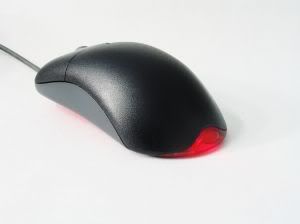Though the fact is that RSI depends more on the posture than on the computer mouse itself, we shall concentrate more on the mouse than on the posture in this article.
Coming back to the topic of selecting a computer mouse, we shall discuss a bit as we go along the criteria for selecting it.

Optical Mouse
Does it fit? - Amongst the various computer mice available, seek the one that best fits your palm. Of course, customization is not possible, but across the various companies and models, the size changes and that might make a difference.
What type do you need? -
a) If you are using the computer for general purposes, it is ok to buy the good old scroll mouse. This is the most common type of computer mouse that has a roller at the bottom and has two buttons and a scroll wheel on the top. It is the cheapest and most widely used.
Disadvantages? – The lint and the debris that get between the roller and the connectors do not let the connectors function properly. Moreover, the accuracy and response of this once mighty computer mouse is not at par with its counterparts today.
b) Suppose you are a graphics designer or a gamer and you do not get a response from your computer mouse that is good enough for you. Enter the optical mouse. It looks the same as a scroll mouse but underneath, there is no roller that slows up the response. Instead, optical mice use a red LED (Light Emitting Diode) that throws red light onto a surface, which bounces off and is captured by a CMOS (Complimentary Metal Oxide Semiconductor) sensor. Now, as you move the mouse, the variations in the image captured by the sensors cause the cursor on your screen to respond accordingly.
Why is it more accurate? – The image response works at close to a hundred times per second. Variations of the optical mice which use laser technology are also available in the market.
c) Want to operate the mouse at a distance? Have a problem with the wires connected to the mouse? That’s when you need a wireless mouse. Most wireless mice that are available in the market are pretty reliable and the best thing about them is the fact that they can be used even when there is no clear line between the PC and the mouse (which is not so in the case of an infrared mice). That is basically because they are radio-based (RF-Radio Frequency) devices and hence do not require any optical or physical connection with the computer.

Wireless Mouse
Issues? – The first of course is the fact that you will need to charge them up for operation. Secondly, the computer will need to have a receiver – an external device, a built in component or a special card that you can place in an expansion slot.
The Bluetooth computer mouse is a type of wireless computer mouse that uses Bluetooth technology to connect to a computer. Another is the RF mice that can operate from a distance of 33m.


2 comments:
Nice post man especially like the way you have started it.Atleast someone considers that choosing a computer mouse is not such a lacklusture job after all.Keep posting this kind of stuff.
Thanks for sharing such useful post with us in which you describe how to choose a computer mouse. If you are using the computer for general purposes then better to buy the good laser scroll mouse.
Post a Comment